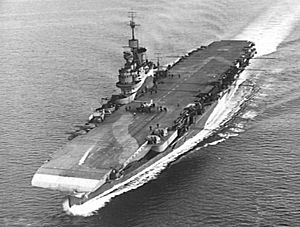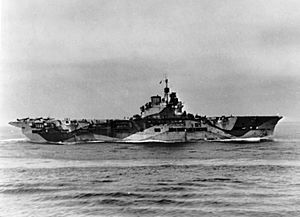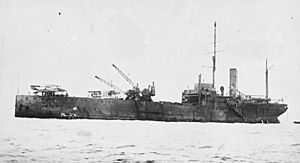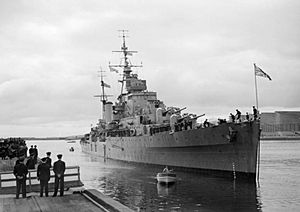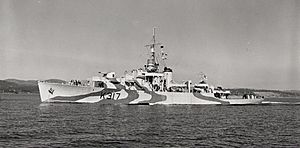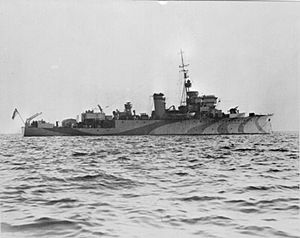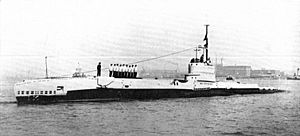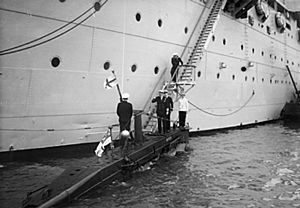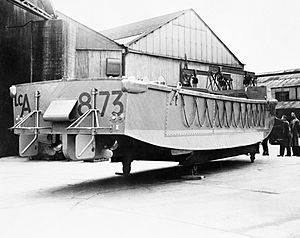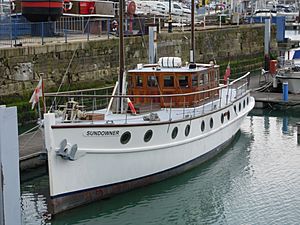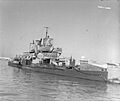List of classes of British ships of World War II facts for kids
This article lists the different types of British ships that were used during World War II. This includes ships that served with the Royal Navy and other British military forces.
Contents
- Aircraft Carriers: Floating Airfields
- Battleships: Naval Giants
- Battlecruisers: Fast and Strong
- Cruisers: Versatile Warships
- Monitors: Coastal Bombardment Ships
- Destroyers: Fast and Fierce
- Frigates: Anti-Submarine Specialists
- Corvettes: Small but Mighty Escorts
- Sloops: Multi-Purpose Patrol Ships
- Minelayers: Laying Underwater Traps
- Minesweepers: Clearing the Way
- Submarines: Silent Hunters
- Naval Trawlers: Fishing Boats Go to War
- Small Armed Boats: Fast and Agile
- Amphibious Warfare Vessels: Landing Troops and Tanks
- Civilian Ships: The Little Ships of Dunkirk
- Images for kids
Aircraft Carriers: Floating Airfields
Aircraft carriers are like floating airfields! They carry planes that can take off and land right on their decks. These ships were super important in World War II for launching air attacks and defending convoys.
Fleet Carriers: Big and Powerful
These were the largest and most powerful aircraft carriers. They could carry many planes and were used for major naval battles.
- HMS Eagle (1918)
- Courageous-class aircraft carrier
- HMS Ark Royal (91)
- Illustrious-class aircraft carrier
- Implacable-class aircraft carrier
Light Aircraft Carriers: Smaller but Nimble

Light carriers were smaller than fleet carriers. They were still very useful for supporting different naval operations.
- HMS Argus (I49)
- HMS Hermes (95)
- HMS Unicorn (I72)
- 1942 Design Light Fleet Carrier
Escort Carriers: Protecting Convoys
Escort carriers were smaller and slower. They were mainly used to protect convoys of merchant ships from enemy submarines and aircraft.
- HMS Pretoria Castle (F61)
- HMS Audacity
- HMS Archer (D78)
- Avenger-class escort carrier
- Attacker-class escort carrier
- Ruler-class escort carrier
- HMS Activity (D94)
- Nairana-class escort carrier
Merchant Aircraft Carriers: Civilian Ships with a Twist
These were regular cargo ships or oil tankers that had a flight deck added on top. They were mostly run by civilian crews, but had some naval staff too. They helped protect convoys.
- Merchant aircraft carriers (MACs)
Seaplane Carriers: Planes on Water
These ships carried seaplanes, which could land and take off from the water.
- HMS Pegasus - used for training and transporting aircraft.
- HMS Albatross - originally from Australia, it became a repair ship for the invasion of France.
Catapult Ships: Launching Fighters
These ships had a special catapult to launch a single fighter plane. They were used to defend convoys against enemy bombers.
- Fighter catapult ships
- CAM ships - civilian ships with a catapult for launching a fighter.
Battleships were the largest and most heavily armed warships. They had huge guns and thick armor, making them very powerful in naval battles.
- Queen Elizabeth-class battleship
- Revenge-class battleship
- Nelson-class battleship
- King George V-class battleship
Battlecruisers: Fast and Strong

Battlecruisers were similar to battleships but were designed to be faster. They had powerful guns but usually less armor than battleships.
- Renown-class battlecruiser
- HMS Hood
Cruisers: Versatile Warships
Cruisers were medium-sized warships that could perform many different tasks. They were used for scouting, protecting convoys, and attacking enemy ships.
Heavy Cruisers: Big Guns
Heavy cruisers had guns larger than 6 inches (about 15 cm). They were powerful ships used for major naval operations.
- Hawkins-class cruiser
- County-class cruiser
- York-class cruiser
Light Cruisers: Faster and More Agile
Light cruisers had guns of 6 inches (about 15 cm) or smaller. They were generally faster and more agile than heavy cruisers.
- C-class cruiser
- Danae-class cruiser
- Emerald-class cruiser
- Leander-class cruiser
- Arethusa-class cruiser
- Town-class cruiser
- Dido-class cruiser
- Fiji-class cruiser
- Minotaur-class cruiser
Armed Merchant Cruisers: Converted Liners
These were passenger liners or cargo ships that were fitted with guns for wartime use. They often protected convoys.
- Armed merchant cruisers
Monitors: Coastal Bombardment Ships
Monitors were ships with very large guns but were slow. They were mainly used to bombard enemy positions on land from the sea, especially during landings.
- Erebus-class monitor
- Roberts-class monitor
Destroyers: Fast and Fierce
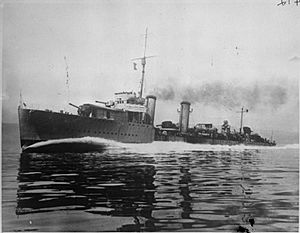
Destroyers were fast, agile warships used for many roles. They protected larger ships from submarines and aircraft, and also carried out torpedo attacks.
Destroyer Leaders: Leading the Pack
These were slightly larger destroyers that led groups (called "flotillas") of other destroyers.
- Thornycroft type destroyer leader
- Admiralty type flotilla leader
Destroyer Classes: Many Types
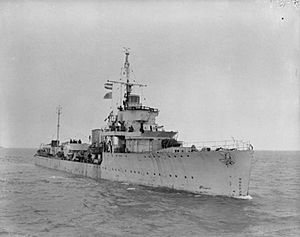
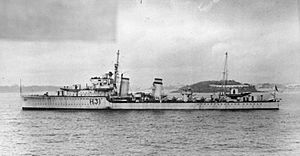
Many different classes of destroyers served during the war, each with slight differences in design and capabilities.
- R-class destroyer - Only HMS Skate from this class was still active.
- V and W-class destroyer
- S-class destroyer
- HMS Ambuscade (D38)
- HMS Amazon (D39)
- A- and B-class destroyer
- C and D-class destroyer
- E and F-class destroyer
- G and H-class destroyer
- I-class destroyer
- Tribal-class destroyer
- J-, K- and N-class destroyer
- L and M-class destroyer
- Hunt-class destroyer
- Town-class destroyer
- O and P-class destroyer
- Q and R-class destroyer
- S and T-class destroyer
- U and V-class destroyer
- W and Z-class destroyer
- C-class destroyer
- Battle-class destroyer
- Weapon-class destroyer
Frigates: Anti-Submarine Specialists
Frigates were smaller than destroyers and were mainly designed for escorting convoys and hunting submarines.
- River-class frigate
- Captain-class frigate
- Colony-class frigate
- Loch-class frigate
- Bay-class frigate
Corvettes: Small but Mighty Escorts
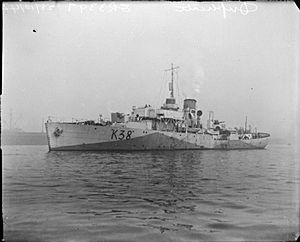
Corvettes were even smaller than frigates. They were cheap to build and very effective at protecting convoys, especially against U-boats.
- Flower-class corvette
- Castle-class corvette
Sloops: Multi-Purpose Patrol Ships
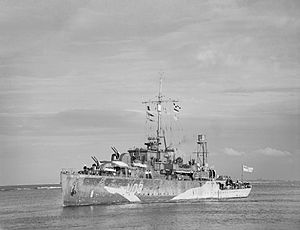
Sloops were versatile ships used for escorting, patrolling, and sometimes even minelaying.
- 24-class sloop
- Bridgewater-class sloop
- Hastings-class sloop
- Banff-class sloop
- Shoreham-class sloop
- Grimsby-class sloop
- Kingfisher-class sloop
- Bittern-class sloop
- Egret-class sloop
- Black Swan-class sloop
Minelayers: Laying Underwater Traps
Minelayers were ships designed to lay naval mines in the water. These mines were hidden traps to sink enemy ships.
- HMS Adventure (M23) - a minelaying cruiser.
- HMS Plover (M26)
- Linnet-class minelayer
- HMS Teviot Bank - an auxiliary minelayer.
- HMS Agamemnon (M10) - an auxiliary minelayer.
- HMS Menestheus - an auxiliary minelayer.
- HMS Port Quebec - an auxiliary minelayer.
- HMS Port Napier
- HMS Southern Prince - an auxiliary minelayer.
- Abdiel-class minelayer - also used as fast transport ships.
Minesweepers: Clearing the Way
Minesweepers were essential ships that cleared naval mines from the sea. They made sure shipping lanes were safe for other vessels.
- Hunt-class minesweeper
- Halcyon-class minesweeper
- MMS-class minesweeper – MMS stands for motor minesweeper.
- Bangor-class minesweeper
- Algerine-class minesweeper
- Auk-class minesweeper – known as Catherine class in British service.
- Cybele-class mine destructor vessel
- BYMS-class minesweeper
Submarines: Silent Hunters
Submarines could travel underwater, making them stealthy hunters. They were used for attacking enemy ships, scouting, and sometimes even laying mines.
- H-class submarine
- L-class submarine
- Odin-class submarine
- Parthian-class submarine
- Rainbow-class submarine
- S-class submarine
- River-class submarine (also known as the Thames class)
- Grampus-class submarine - minelaying submarines.
- T-class submarine (also known as the Triton class)
- U-class submarine
- P611-class submarine
- V-class submarine
- Amphion-class submarine
Midget Submarines: Tiny but Brave
These were very small submarines, often used for special missions like attacking ships in harbors.
- X-class submarine
- XE-class submarine
Many fishing trawlers were converted into naval ships during the war. They were used for minesweeping, anti-submarine patrols, and escort duties.
- Mersey-class trawler
- Isles-class trawler
- Tree-class trawler
- Dance-class trawler
- Shakespearian-class trawler
- Round Table-class trawler
Small Armed Boats: Fast and Agile
These were smaller, faster boats used for coastal patrols, attacking enemy ships with torpedoes, or rescuing downed aircrew.
- Motor Launches
- Fairmile A motor launch
- Fairmile B motor launch
- Harbour Defence Motor Launches
- Motor torpedo boats
- Vosper 73 ft motor torpedo boat
- Fairmile D motor torpedo boat
- Motor gun boats
- Fairmile C motor gun boat
- Steam Gun Boats
- High-speed launches (HSL) - operated by the Royal Air Force Marine Branch to rescue RAF aircrew at sea.
- Type Two 63 ft HSL
Amphibious Warfare Vessels: Landing Troops and Tanks
These ships were specially designed to transport and land troops, vehicles, and equipment directly onto enemy beaches during invasions.
- Landing ship, infantry
- Landing Craft Assault
- Fairmile H landing craft
- LCPL
- LCM 1
- Landing Ship, Tank (LST)
- Maracaibo-class tank landing ship
- Boxer-class
Headquarters Ships: Command Centers Afloat
These ships served as floating command centers during amphibious operations, coordinating the landings.
- LST1 tank landing ship - later became a fighter direction ship.
- Headquarters ship
Civilian Ships: The Little Ships of Dunkirk
Many civilian ships, including fishing boats, yachts, and ferries, played a vital role in rescuing soldiers during the war, most famously during the Dunkirk evacuation.
Images for kids


